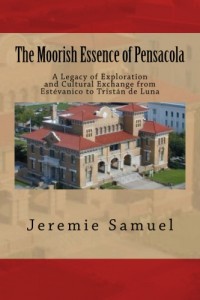The story of the Moors on the Gulf Coast
- October 7, 2015
- / Reggie Dogan
- / community-dashboard

Six years before Spanish explorers landed at St. Augustine, Don Tristan de Luna founded America’s first European settlement in 1559.
Two years later the Spanish settlement was gone as a result of myriad problems, including a catastrophic hurricane.
We call the lost settlement Pensacola today.
But before Tristan de Luna and Pensacola came Estevanico and the Moors.
History records that Moroccan-born Estevanico reached Pensacola’s sandy shores in 1528, 31 years before Tristan de Luna’s arrival.
Estevanico was a Berber and one of the first known native Africans to reach the present-day continental United States. He is known by many different names, but is commonly known as Esteban de Dorantes, Estebanico and Esteban the Moor.
Through his research and writing, Pensacola native Jeremie Samuel wants more people to know about Estevanico and the Moors’ influence in Northwest Florida.
“The Moorish Essence of Pensacola: A Legacy of Exploration and Cultural Exchange from Estevanico to Tristan de Luna” is available on Amazon.com
The book's release includes the following local events:
Oct. 15: Book Unveiling at 301 Barcelona St., Pensacola.
Oct 16:: Moorish Essence Vendors at Gallery Night in Seville, Pensacola.
For more information about the book and author, visit https://littlealandalus.wordpress.com/ or the Facebook page: The Moorish Essence of Pensacola-Book.
In his new book,” The Moorish Essence of Pensacola: A Legacy of Exploration and Cultural Exchange from Estevanico to Tristan de Luna,” Samuel explores a part of Pensacola history that often gets downplayed in discussions about Pensacola's rich and storied history.
The book follows the story of the Moors on the Gulf Coast and uncovers the rich, hidden cultural treasures of North America’s first port city and their influence in the Pensacola area, which are still visible today.
“I have a desire to connect the lost history of my ancestors and the Moors,” said Samuel, a 2010 graduate and English major at Florida State University. “Contemporary historians have overlooked or ignored the Moorish contribution.”
In cooperation with the University of West Florida Office for Economic Development and Engagement, the Studer Insitute has created a dashboard of 16 metrics to provide an at-a-glance look at the area’s growth, educational attainment, economic prospects, safety and civic life.
Cultural enrichment through education and historic exploration helps improve people’s lives and the community’s overall quality of life.
Samuel’s book chronicles the arrival of Spanish explorers on the Gulf Coast. Estevanico, often called “the Black,” was a Morroccan slave who accompanied Cabeza de Vaca on his odyssey through the south and southwestern U.S.
A Tate High School graduate, Samuel has long been interested in Pensacola’s diverse cultural foundaiton and history.
Samuel explained how explorers embarked on the quest to find new setttlements, before arriving on the shores of Pensacola in 1528, highlighting Estevanico’s influence in the region.
After the explored packed up and went west toward Texas, only four men out of a 600-man crew.
Estevanico was certainly the first African to traverse Texas, and in the company of three Spainards reentered Texas from Mexico.
Throughout their travels in Floirda, Texas ad Mexivo, the three Spainiards and Estevanico gained fame and sustenance as faith healers among Native Americans.
“His ability to collaborate with different cultures, mainly Native Americans, really helped the explorers survive,” Samuel said. “I wrote this book to keep the story of Estevanico all and well in the hearts and soul of people who read and study history.”

 CivicCon launches with a look at good growth in cities
CivicCon launches with a look at good growth in cities
 Building stronger brains one baby, one parent at a time
Building stronger brains one baby, one parent at a time
 SCI debuts commercial on Early Learning City
SCI debuts commercial on Early Learning City
 Entrecon: World class speakers and an opportunity to sharpen skills
Entrecon: World class speakers and an opportunity to sharpen skills
 PYP Quality of Life survey 2017
PYP Quality of Life survey 2017
 EntreCon Pensacola 2016: A look back
EntreCon Pensacola 2016: A look back
 Leadership tip: getting better employee takeaways
Leadership tip: getting better employee takeaways
 Leadership tip: be interested instead of interesting
Leadership tip: be interested instead of interesting
 Leadership tip: delivering difficult messages
Leadership tip: delivering difficult messages
 Brain Bags boost Arc, Early Childhood Court programs
Brain Bags boost Arc, Early Childhood Court programs